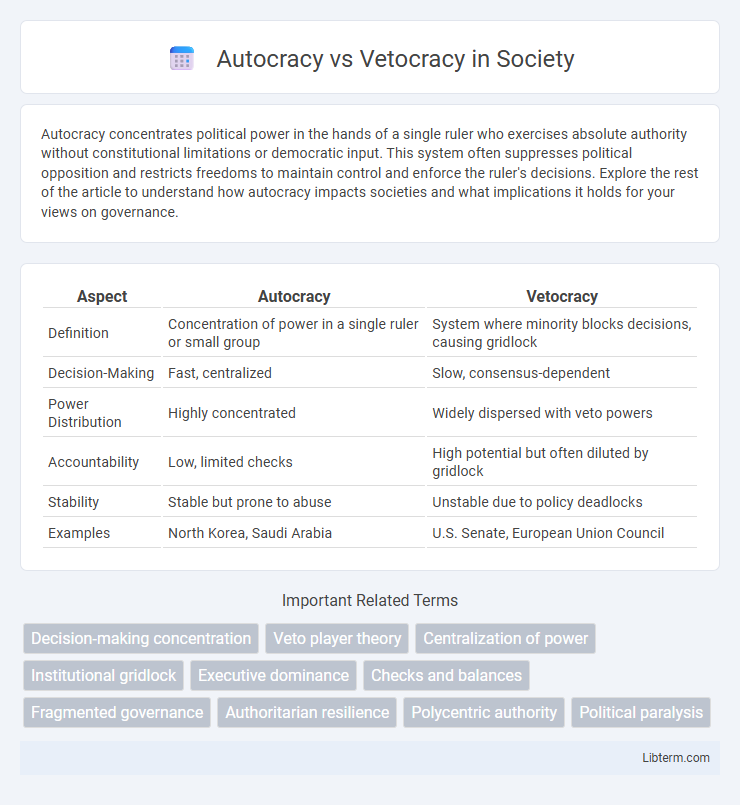Autocracy concentrates political power in the hands of a single ruler who exercises absolute authority without constitutional limitations or democratic input. This system often suppresses political opposition and restricts freedoms to maintain control and enforce the ruler's decisions. Explore the rest of the article to understand how autocracy impacts societies and what implications it holds for your views on governance.
Table of Comparison
| Aspect | Autocracy | Vetocracy |
|---|---|---|
| Definition | Concentration of power in a single ruler or small group | System where minority blocks decisions, causing gridlock |
| Decision-Making | Fast, centralized | Slow, consensus-dependent |
| Power Distribution | Highly concentrated | Widely dispersed with veto powers |
| Accountability | Low, limited checks | High potential but often diluted by gridlock |
| Stability | Stable but prone to abuse | Unstable due to policy deadlocks |
| Examples | North Korea, Saudi Arabia | U.S. Senate, European Union Council |
Defining Autocracy and Vetocracy
Autocracy is a system of governance where a single individual holds absolute power, controlling decisions without input or opposition from others. Vetocracy, in contrast, occurs when multiple parties possess the power to veto decisions, resulting in gridlock and an inability to govern effectively. The defining difference lies in autocracy's centralized authority versus vetocracy's dispersed power that hampers decision-making.
Historical Origins and Evolution
Autocracy, rooted in ancient civilizations like Mesopotamia and Egypt, emerged as a system where absolute power centralized in one ruler ensured swift decision-making and control. Vetocracy evolved from complex democratic frameworks, notably in Roman Republic and early American governance, where multiple actors wielded veto powers to prevent tyranny and protect diverse interests. The historical evolution of autocracy emphasizes centralized authority, while vetocracy reflects institutionalized checks designed to balance power and avoid autocratic dominance.
Core Principles and Mechanisms
Autocracy centralizes power in a single ruler or a small group, emphasizing decisive authority and top-down decision-making, while vetocracy relies on multiple veto points allowing various actors to block proposals, promoting checks and balances but often causing gridlock. Core principles of autocracy include unilateral control and limited accountability, enabling swift policy implementation, whereas vetocracy is grounded in power dispersion and consensus-building, prioritizing protection against dictatorship at the cost of efficiency. Mechanisms in autocracy involve concentrated executive powers and minimal legislative constraints, contrasting with vetocracy's institutional structures that empower diverse stakeholders and enforce mutual veto rights.
Key Differences Between Autocracy and Vetocracy
Autocracy centralizes decision-making power in a single leader or a small group, enabling swift and unilateral actions, whereas vetocracy disperses authority across multiple stakeholders who possess veto power, often leading to slow or stalled decisions. Key differences include the concentration of power, where autocracies enable rapid enforcement of policies, and vetocracies emphasize consensus, frequently resulting in gridlock and inefficiency. Autocracies risk authoritarianism due to unchecked power, while vetocracies prioritize checks and balances to prevent dominance by any single actor.
Political Stability and Governance Efficiency
Autocracy centralizes power in a single ruler, often resulting in swift decision-making and high governance efficiency but risks political instability due to potential authoritarianism and lack of public accountability. Vetocracy disperses authority among multiple actors with veto power, enhancing checks and balances and political stability by preventing unilateral actions but frequently leads to governance gridlock and inefficiency. Balancing political stability and governance efficiency depends on the concentration or diffusion of power inherent in autocratic or vetocratic systems.
Impacts on Civil Liberties and Rights
Autocracy centralizes power, often leading to the suppression of civil liberties and the erosion of political rights as dissent is frequently stifled under authoritarian rule. Vetocracy, characterized by dispersed veto powers, can frustrate collective decision-making but typically preserves greater individual freedoms by preventing any single entity from wielding unchecked control. Both systems influence civil liberties distinctly: autocracies limit freedom through concentrated authority, while vetocracies maintain pluralism at the cost of political gridlock.
Case Studies: Examples from Around the World
Autocracy in Russia under Vladimir Putin demonstrates centralized control with limited political opposition, enabling rapid decision-making but restricting democratic freedoms. In contrast, Lebanon exemplifies vetocracy, where sectarian power-sharing creates multiple veto points, leading to political paralysis and government dysfunction. South Africa's transition from apartheid to democracy highlights the dangers of autocracy and the benefits of inclusive governance, while the United States' vetocratic system ensures checks and balances but can result in legislative gridlock.
Challenges and Criticisms
Autocracy often faces criticism for concentrating excessive power in a single leader, leading to potential abuses and lack of accountability, which undermines democratic principles. Vetocracy creates a gridlock by allowing any stakeholder to veto decisions, resulting in inefficiency and stagnation that can hinder policy implementation and reform. Both systems struggle with balancing authority and participation, posing significant challenges to effective governance and social stability.
Implications for Modern Governance
Autocracy centralizes political power in a single authority, often leading to efficient decision-making but risking authoritarianism and limited public accountability. Vetocracy occurs when multiple entities hold veto power, causing gridlock and impeding policy implementation despite democratic intentions. Modern governance must balance these dynamics by ensuring sufficient authority for effective action while maintaining checks that prevent abuse and foster inclusive participation.
Future Trends and Prospects
Autocracy, characterized by centralized power, may face increasing resistance as global demands for transparency and participatory governance grow, pushing toward hybrid models integrating technology-driven citizen engagement. Vetocracy, defined by excessive veto powers causing decision-making gridlock, could prompt reforms favoring streamlined legislative processes and enhanced executive authority to address urgent societal challenges. Emerging trends indicate a dynamic interplay where future governance systems might balance authoritative control with collaborative mechanisms to ensure both stability and adaptability.
Autocracy Infographic

 libterm.com
libterm.com